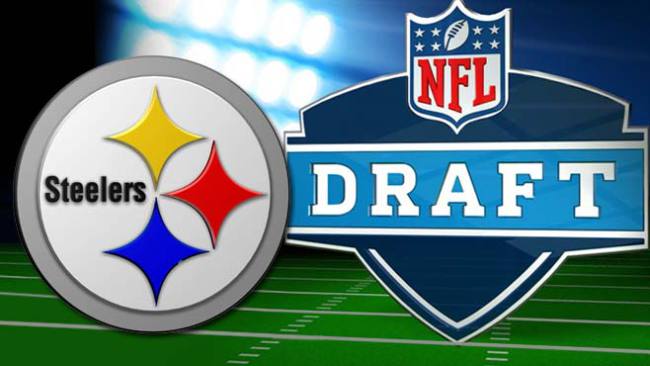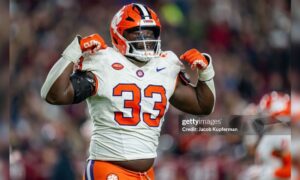The Pittsburgh Steelers have a well-earned reputation of building through the draft. With only 6 picks and no first rounder, that approach will be challenged in 2020. (Though Minkah Fitzpatrick and Devin Bush may have been worth the sacrifice.)
This draft class won’t resemble 1974, but general manager Kevin Colbert has a chance to add contributors for years to come. How much of a contribution should we expect? We can look at large-scale studies about approximate value per round and league-wide starters per draft round to get a sense of expected production. We can also look at actual results from the Colbert-Tomlin era, 2007-2019.
We analyzed all 107 Steelers picks from the last 12 years to see how many became established starters by draft year, round and position. Here is the full data set. The sample sizes are small, but the results shed some light on where the Steelers have found success.
First, a couple notes about methodology. For these purposes, it takes 8 games started for a player to be considered an established starter. This analysis looks at how many regular season Steelers games it took for a player to get to his 8th start. That includes non-starter, inactive, suspended, free agent and practice squad status, but does not include games on Injured Reserve. Players drafted by the Steelers but who reached start 8 with another team (e.g. Kraig Urbik) are included. This overall set of criteria led to a few questionable “starters” (Cortez Allen, anyone?), but largely mitigated the impact of outliers on the analysis.
Draw conclusions as you would like and share them in the comments, but here are a few snapshots:
Overall
| OVERALL | # Total | # Starters | % Starters | Avg. Games to 8th Start | Avg. Seasons to 8th Start | # Non-Starters | % Non-Starters |
| Total | 107 | 48 | 44.9% | 24.0 | 1.5 | 59 | 55.1% |
Starters by Round
| ROUND | # Total | % Total | # Starters | % Starters | Avg. Games to 8th Start | Avg. Seasons to 8th Start | # Non-Starters | % Non-Starters |
| 1 | 13 | 12.1% | 13 | 100.0% | 19.2 | 1.2 | 0 | 0.0% |
| 2 | 11 | 10.3% | 9 | 81.8% | 19.2 | 1.2 | 2 | 18.2% |
| 3 | 18 | 16.8% | 11 | 61.1% | 24.8 | 1.6 | 7 | 38.9% |
| 4 | 13 | 12.1% | 4 | 30.8% | 29.8 | 1.9 | 9 | 69.2% |
| 5 | 18 | 16.8% | 3 | 16.7% | 32.7 | 2.0 | 15 | 83.3% |
| 6 | 17 | 15.9% | 4 | 23.5% | 37.5 | 2.3 | 13 | 76.5% |
| 7 | 17 | 15.9% | 4 | 23.5% | 25.0 | 1.6 | 13 | 76.5% |
To the Steelers credit, there are few surprises in how many players became starters. Still, achieving 100% starting status for all first rounders (yes, that includes Artie Burns, who started 32 games) deserves attention. There is a drop off after round 3, where it goes from 61.1% starters to only 30.8% starters in round 4, thanks to misses on guys like Jerald Hawkins, Doran Grant, Shamarko Thomas, Alameda Ta’amu and others. With 15 established starters selected in rounds 4-7 across 12 years, the team is averaging a little more than 1 starter per year in the latter rounds.
Of particular note is how long, on average, it took for players to become established starters. As a group, first and second rounders needed to get to the beginning of their second season to be firmly entrenched as starters. Third and fourth rounders solidified their starting status later in year 2. And strangely, the same goes for seventh rounders, with the help of Kelvin Beachum and David Paulson. Fifth and sixth rounders cross the threshold in year 3.
Starters by Position
| POSITION GROUP | # Total | % Total | # Starters | % Starters | Avg. Games to 8th Start | Avg. Seasons to 8th Start | # Non-Starters | % Non-Starters |
| ST | 2 | 1.9% | 1 | 50.0% | 8.0 | 0.5 | 1 | 50.0% |
| RB | 10 | 9.3% | 3 | 30.0% | 16.0 | 1.0 | 7 | 70.0% |
| OL | 15 | 14.0% | 8 | 53.3% | 19.6 | 1.2 | 7 | 46.7% |
| LB | 22 | 20.6% | 11 | 50.0% | 21.8 | 1.4 | 11 | 50.0% |
| WR/TE | 20 | 18.7% | 12 | 60.0% | 24.5 | 1.5 | 8 | 40.0% |
| QB | 4 | 3.7% | 1 | 25.0% | 27.0 | 1.7 | 3 | 75.0% |
| DL | 13 | 12.1% | 5 | 38.5% | 28.8 | 1.8 | 8 | 61.5% |
| DB | 21 | 19.6% | 7 | 33.3% | 34.9 | 2.2 | 14 | 66.7% |
Ignore special teams draftees, who had the shortest routes to starting but only a sample size of two (Daniel Sepulveda and Colin Holba). And you can gloss over quarterback, where Mason Rudolph earned starter status due to Ben Roethlisberger’s injury.
But beyond those, things get interesting. First, wide receivers and tight ends hit 60% of the time, a credit to the scouting staff’s ability to identify pass catchers (or perhaps Ben’s ability to throw to them). Offensive linemen and linebackers also hit more than 50% of the time, across all rounds. Running backs have been mostly misses, but when they hit, they start quickly, as evidenced by reaching 8 starts within their first year. Defensive backs, long Colbert’s Achilles’ heel in the draft, predictably converted to starters at a low rate. Two thirds of the secondary picks never became primary contributors, with cringe-worthy names including Senquez Golson, Shaquille Richardson, Terry Hawthorne, Curtis Brown and Crezdon Butler. In addition, defensive backs who did make the starting lineup took the longest to get there. A good example is Keenan Lewis, who didn’t establish himself as a starter until his fourth season.
Starters by Draft Year
| DRAFT YEAR | # Total | # Starters | % Starters | Avg. Games to 8th Start | Avg. Seasons to 8th Start | # Non-Starters | % Non-Starters |
| 2019 | 9 | 2 | 22.2% | 9.5 | 0.6 | 7 | 77.8% |
| 2018 | 7 | 3 | 42.9% | 18.3 | 1.1 | 4 | 57.1% |
| 2017 | 8 | 3 | 37.5% | 16.3 | 1.0 | 5 | 62.5% |
| 2016 | 7 | 3 | 42.9% | 14.0 | 0.9 | 4 | 57.1% |
| 2015 | 8 | 3 | 37.5% | 25.7 | 1.6 | 5 | 62.5% |
| 2014 | 9 | 3 | 33.3% | 23.0 | 1.4 | 6 | 66.7% |
| 2013 | 9 | 4 | 44.4% | 16.3 | 1.0 | 5 | 55.6% |
| 2012 | 9 | 5 | 55.6% | 17.0 | 1.1 | 4 | 44.4% |
| 2011 | 7 | 3 | 42.9% | 32.7 | 2.0 | 4 | 57.1% |
| 2010 | 10 | 5 | 50.0% | 33.6 | 2.1 | 5 | 50.0% |
| 2009 | 9 | 6 | 66.7% | 31.2 | 1.9 | 3 | 33.3% |
| 2008 | 7 | 2 | 28.6% | 40.5 | 2.5 | 5 | 71.4% |
| 2007 | 8 | 6 | 75.0% | 27.8 | 1.7 | 2 | 25.0% |
It’s too early to judge the recent draft classes, especially in light of the fact that it takes roughly 1.5 seasons, on average, to become an established starter with the Steelers. There are a few strong years that stand out, including 2007 (led by Lawrence Timmons, LaMarr Woodley, Matt Spaeth, William Gay and yes, Sepulveda) and 2009 (Ziggy Hood, Mike Wallace, Keenan Lewis), though the numbers for both classes benefited from players who established themselves after they left Pittsburgh (Kraig Urbik, A.Q. Shipley and Ryan McBean).
Most interesting is the speed in which players have become starters. From 2007-2011, it took 31.8 games for draft picks to become established starters. From 2012-present, that number has been 17.7 — almost twice as fast. In fact, 2007-2011 represent the five slowest years for Steelers’ picks to become entrenched in the starting lineup. Was there a philosophical shift in player development in 2012? Has the team drafted and developed higher upside players in the last seven years? Have salary cap constraints created more pressure to get production from first and second-year players? Or is this just a sample size anomaly?
Class of 2020 Expectations
The Steelers have 6 picks (rounds 2, 3, 4, 4, 6 and 7) in the draft, which starts Thursday evening. Based on the last 12 years, and removing data from first and fifth-round picks, 42.1% — or 2-3 players — of this class will become established starters. And as you might expect, odds favor the second and third-round picks, especially if they are at receiver, offensive lineman or linebacker. (Or punter, but let’s hope that doesn’t happen.) Be glad Colbert doesn’t have any fifth-round picks to waste this year, since only 3-of-18 have hit as starters during his tenure.
While draftees are establishing themselves as starters faster in recent years than early in the Colbert/Tomlin administration, it is still taking a full year, on average, for players to reach 8 starts. And without a first-round pick, the waiting time is extended. Third-round picks, for example, typically don’t start during their first year. There are exceptions, of course — Diontae Johnson this past year is a good example.
But based on history, Steelers fans shouldn’t expect this class to include any day 1 starters. Not that it can’t happen. Outside of the first 2 rounds, the Steelers are often producing starters that replace their predecessors — if they become starters at all — in year 2 or 3.
That may be why Colbert spent the offseason shoring up some holes — without a first-round pick, he knows his selections will need time to become established starters. Signing (or, in some cases, resigning) guys like Stefen Wisniewski, Eric Ebron and potential starter Zach Banner — all to 1 or 2-year deals — gives the team time to develop draft picks before throwing them into the lineup.
And assuming, as we should, the Steelers understand the average development timeline for their draft picks, there may be some positions that they may prioritize in this draft, even if Colbert says he will take a “best player available” approach. Here are the position groups that have current starters over the age of 30 or with contracts that expire after this season:
| POSITION GROUP | Over 30 | Expiring Contract |
| RB | James Conner | |
| OL | David DeCastro, Maurkice Pouncey, Alejandro Villanueva | Alejandro Villanueva, Matt Feiler |
| LB | Vince Williams | Bud Dupree |
| WR/TE | JuJu Smith-Schuster | |
| QB | Ben Roethlisberger | |
| DL | Cameron Heyward | Cameron Heyward |
| DB | Joe Haden | Mike Hilton |
| ST | Jordan Berry |
There are few lineup question marks, such as who will play left guard and right tackle, or who will play nose tackle, and many of those potential starters have expiring contracts, which could be a factor on draft day. Bud Dupree, JuJu Smith-Schuster and Cameron Heyward have all been the subject of contract extensions, so those potential holes may be remedied (though Heyward is also north of 30). Roethlisberger isn’t going anywhere … yet.
There are a few soft spots. Offensive line is the most obvious — the 4 known starters are all either aging or unsigned after 2020, and 2 of the options for the fifth starter (Wisniewski and Banner) are in the same boat. Running back, inside linebacker and possibly cornerback are the other potential weaknesses after this year.
Between 2-3 of this year’s draft class may be expected to become starters by their second season, so don’t be surprised if Colbert and head coach Mike Tomlin take a hard look at offensive line, running back, inside linebacker or cornerback with the first few picks. No matter where they go, history says fans should be patient with how quickly the draftees become established starters. Unless they draft a punter.








